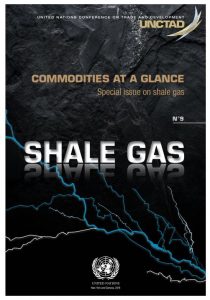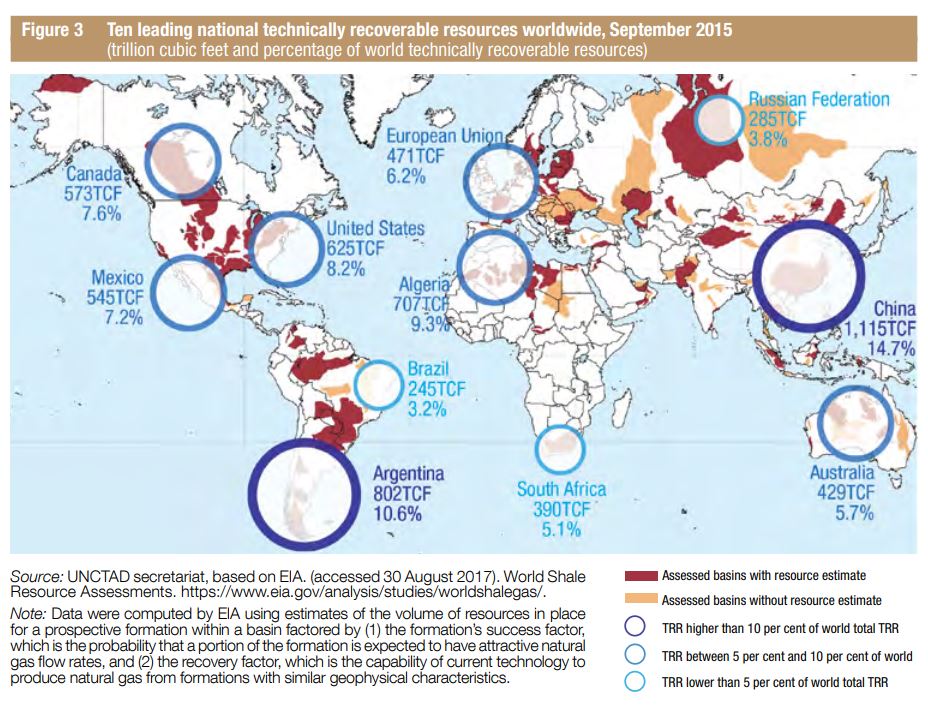New UN report warns members to approach hydraulic fracturing with caution; says don’t invest in shale at the expense of renewables
The United Nations Conference on Trade and Development has published a new report looking at the global shale gas phenomenon. The report is called “Commodities at a Glance, Special Issue on Shale Gas.”
 In an accompanying press release, the UN Conference on Trade and Development, whose slogan is “Prosperity for All,” said that hydraulic fracturing “should be approached with caution by countries seeking ways to increase access to energy.”
In an accompanying press release, the UN Conference on Trade and Development, whose slogan is “Prosperity for All,” said that hydraulic fracturing “should be approached with caution by countries seeking ways to increase access to energy.”
The UN lectures that “investments in the shale gas sector should not be made at the expense of the deployment of renewable energies and energy efficiency strategies.”
In a familiar chorus, the press release quoted the UN secretary-general as saying, “Climate change means that all countries must, as a matter of strategic urgency, move away from burning fossil fuels, including shale gas.”
But the secretary general went on to concede that “energy is needed to end poverty and boost development” and “countries with potential shale gas resources should understand the pros and cons when they take policy decisions about the short-term energy mix.”
As to advantages provided by natural gas, the UN report includes these benefits:
- Natural gas emits about 40% less CO2 per unit of energy produced than coal.
- It can be stored and used on demand to meet variable energy needs more efficiently than energy generated from renewable sources such as wind.
On the negative side the UN says, “natural gas remains a fossil fuel that emits harmful CO2 when burned. Besides, while the main component of natural gas, methane (CH4), has a shorter atmospheric lifespan than CO2, its global warming potential is 28 times higher than that of CO2 on a 100-year time horizon.” The report also expressed concern about potential seismicity linked to shale gas activities and the large quantities of water used by hydraulic fracturing, as well as “the potential risks generated by shale gas operations, on the quality of such resources through groundwater or surface water contamination.”
Abundant supply: the world’s supply of shale gas can generate global prosperity for 60 years

The UN report cites the EIA’s statistic that world Technically Recoverable Resources (TRR) for shale gas were around 215 trillion cubic meters in 2015, equivalent to about 60 years’ worth of world consumption. And about half of these resources are located in Algeria, Argentina, Canada, China and the United States.
Source: United Nations Conference on Trade and Development
U.S – international shale gas leader
The UN reports that the United States remained the leading shale gas producing country in 2015 with 87% of the world total. The United States became a net-exporter of natural gas starting from July 2017.
Also, the UN report concludes that large investments made to develop the liquefaction infrastructure in the United States could lead the U.S. to hold the third largest capacities by 2020, after Australia and Qatar. Such developments could potentially lead to globalization in the natural gas market which is currently regionalized.
The future of fossil fuels: they’re not going anywhere anytime soon
The UN reports that, fossil fuels are expected to remain the main source of energy to 2040 and that in 2016, more than 85% of world energy demand was met through the use of fossil fuels. The UN expects share of renewables in the global energy mix to range from 16.1% to 19.3% per cent in 2040, with the highest renewable scenario approaching 31% by 2040. In other words, the UN’s experts foresee fossil fuels to continue to provide between 69% and 84% of global energy, even 22 years in the future.
Global energy consumption to grow by 20%; here’s where the fuel will come from
The UN shale gas report says global energy consumption is expected to grow by more than 20% by 2035, mainly fueled by demand from non-OECD countries in Asia.
With regard to natural gas, its share in the global energy mix may rise by 3 percentage points by 2035, owing to increasing demand from the power generation and industrial sectors. This may lead to natural gas accounting for 24% of the global energy mix by 2035, according to the report.
North America and China will become world’s biggest shale gas producers
The UN report sees about one fifth of this gas demand being supplied by shale gas production, “mainly from North America, in particular the United States, as well as from China, where shale gas may account for half of national natural gas production by 2040.”
The UN says that share of renewable energies in the global energy mix may account for 19% of the global energy mix by 2035. That leaves the other 81% as coming from fossil fuels.
UN wrestling with shale gas issue
The report says that looking at current trends in the shale gas sector it’s time to evaluate “the role that natural gas is expected to play in the future energy landscape.”
The UN believes that “natural gas is pointed out as a bridge fuel by the Intergovernmental Panel on Climate Change, when it is used as a source of energy that emits less CO2. However, although it is less carbon intensive than oil or coal, for instance, natural gas also emits CO2 into the atmosphere and contributes to global warming. Moreover, the issue of fugitive CH4 emissions must be particularly taken into consideration and mitigation strategies applied.”
UN calling for a ‘smooth transition’ from today’s fossil-fueled economic model to a low-carbon economy
The UN report calls for a ‘smooth transition’ from the current economic model, which it says is mainly based on fossil fuels. It wants to move the world away from a fossil-fueled economy “to achieving a low-carbon economy, with the objective of meeting the Sustainable Development Goal 7 by 2030.” That goal calls for “access to affordable, reliable, sustainable and modern energy for all.”
Realities of achieving the UN’s goal—here is a clean, abundant, reliable, mobile, affordable fuel source – it’s called LNG, and ~63 MTPA will be available to ship worldwide from the U.S. in 2020
The year the UN set to achieve the goal—2030—is only twelve years away. The abundant supply of U.S. shale gas along with the country’s fast-growing list of export terminals for liquefied natural gas (LNG), offer up a ready fuel source which has the best chance to deliver on the UN’s promise.

Natural gas could be defined as ‘modern’ when you examine the high-technology, super-efficient combined cycle turbines in a modern gas-fired power plant, and it can deliver baseload (i.e. reliable, not intermittent) electrical power while generating 40%-50% less carbon dioxide emissions (i.e., clean) than a coal plant. It’s definitely affordable, and it will fuel the industrial growth sought by non-OECD nations, as referenced in the report’s energy consumption section.
By providing swift global access to cheap natural gas to fuel the creation of new industries, drive jobs and provide the power for any country’s economic growth, U.S. shale gas is positioned to be the energy source that allows the United Nations Conference on Trade and Development to live up to its slogan of “Prosperity for All.”
Download the UN report on shale gas here.






